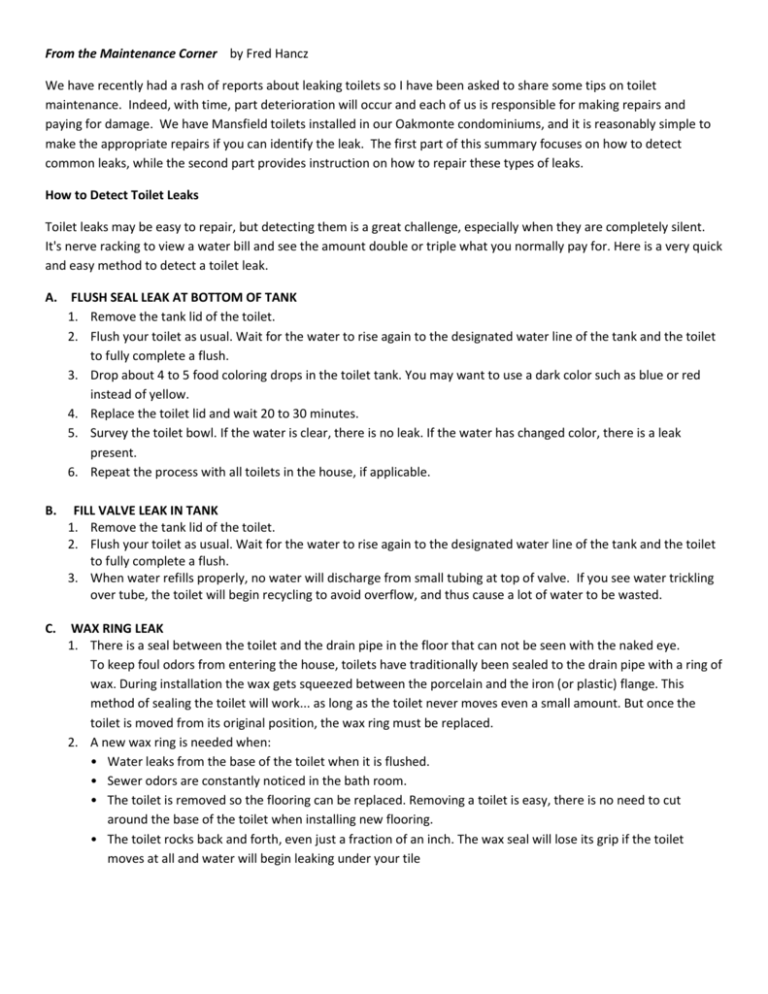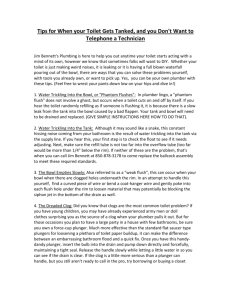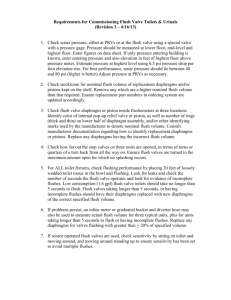From the Maintenance Corner by Fred Hancz
advertisement

From the Maintenance Corner by Fred Hancz We have recently had a rash of reports about leaking toilets so I have been asked to share some tips on toilet maintenance. Indeed, with time, part deterioration will occur and each of us is responsible for making repairs and paying for damage. We have Mansfield toilets installed in our Oakmonte condominiums, and it is reasonably simple to make the appropriate repairs if you can identify the leak. The first part of this summary focuses on how to detect common leaks, while the second part provides instruction on how to repair these types of leaks. How to Detect Toilet Leaks Toilet leaks may be easy to repair, but detecting them is a great challenge, especially when they are completely silent. It's nerve racking to view a water bill and see the amount double or triple what you normally pay for. Here is a very quick and easy method to detect a toilet leak. A. FLUSH SEAL LEAK AT BOTTOM OF TANK 1. Remove the tank lid of the toilet. 2. Flush your toilet as usual. Wait for the water to rise again to the designated water line of the tank and the toilet to fully complete a flush. 3. Drop about 4 to 5 food coloring drops in the toilet tank. You may want to use a dark color such as blue or red instead of yellow. 4. Replace the toilet lid and wait 20 to 30 minutes. 5. Survey the toilet bowl. If the water is clear, there is no leak. If the water has changed color, there is a leak present. 6. Repeat the process with all toilets in the house, if applicable. B. FILL VALVE LEAK IN TANK 1. Remove the tank lid of the toilet. 2. Flush your toilet as usual. Wait for the water to rise again to the designated water line of the tank and the toilet to fully complete a flush. 3. When water refills properly, no water will discharge from small tubing at top of valve. If you see water trickling over tube, the toilet will begin recycling to avoid overflow, and thus cause a lot of water to be wasted. C. WAX RING LEAK 1. There is a seal between the toilet and the drain pipe in the floor that can not be seen with the naked eye. To keep foul odors from entering the house, toilets have traditionally been sealed to the drain pipe with a ring of wax. During installation the wax gets squeezed between the porcelain and the iron (or plastic) flange. This method of sealing the toilet will work... as long as the toilet never moves even a small amount. But once the toilet is moved from its original position, the wax ring must be replaced. 2. A new wax ring is needed when: • Water leaks from the base of the toilet when it is flushed. • Sewer odors are constantly noticed in the bath room. • The toilet is removed so the flooring can be replaced. Removing a toilet is easy, there is no need to cut around the base of the toilet when installing new flooring. • The toilet rocks back and forth, even just a fraction of an inch. The wax seal will lose its grip if the toilet moves at all and water will begin leaking under your tile _________________________________________________________________________________________________ A. How To Repair A Leaking Mansfield Flush Valve Seal Repair is a simple task that many people will not undertake because the design of the Mansfield flush valve is so different than many other toilets. In reality it is no more difficult than changing a flapper in a conventional toilet.Most of the Mansfield toilets in service today utilize a unique flush tower design that many people just look at and cannot quite figure out how to work on. There are four basic designs but, all are very similar and just two easily identifiable seals are used on the model 208, 209, 210, and 211 flush valves. The Mansfield flush valves all are secured through the tank with a nut and rubber seal holding it in place. There is a horn shaped tower that has the bell of the horn on top of one of the two seals, the narrow part of the horn goes up above the water line and is held in place by a guide rod with a stop bumper on the top. The tank lever causes the toilet to flush by either going through a loop on the upper end of the horn or, a chain that runs from the bell end of the horn up to the handle. Either way the tank lever lifts the horn up against the stop bumper, allowing water to flow under the bell end into the toilet bowl, causing the toilet to flush. After flushing, the horn drops back down in place with the bell again sealing against the base of the valve stopping the water flow into the bowl. While the tank is refilling a tube from the fill valve secured into the center of the stop bumper runs Identifying Which Mansfield Flush Valve Seal To Use Identifying which seal is use is simple there are only two to pick from. Toilets that have the Mansfield 208 and 209 flush valves use a black rubber seal that secures to the bell und of the horn and the seal raise and lower with the horn when the toilet flushes. Toilets that use the Mansfield 208 and 209 flush valve use the Mansfield # 630-4837 flush valve seal but you may also use a Korky # 426BP flush valve seal. This seal snaps in place over the bell end of the horn similar to putting the lid on a Tupperware container. Toilets that have the Mansfield 210 and 211 flush valves use a rubber seal that is usually but not always red in color and secures in a groove located on the stationary base of the flush valve on the section that doesn’t move up and down with the horn when the toilet flushes. The bell end rises off the seal when the toilet flushes and comes back down on it on the completion of the flush. Toilets that use the Mansfield 210 and 211 flush valves use the Mansfield # 630-0030 flush valve seal but you may also use the Korky # 427BP flush valve seal. Replacing Mansfield Flush Valve Seal The replacement of the Mansfield flush valve seal is very similar on all four of the flush valve models. When replacing the black rubber flush valve seal I encourage you to wear latex or, nitrile gloves as the deteriorating black rubber will stain your hands badly and once it is removed I usually hold it in my palm and pull the glove off from the wrist bagging the old seal in the glove. Turn off the water supply to the toilet usually at the stop valve under the left side of the tank. Remove the tank lid and place it on the floor out of the way, placing the lid on the floor is something you should do to prevent the lid from getting broken. (Buying a replacement tank lid can be quite expensive costing up to $150 plus shipping.) Flush the toilet and verify the water is off, then pull the bowl refill tube out of the stop bumper on the on the top of the flush valve. Unscrew the stop bumper of the top of the flush tower and set the stop bumper aside. Raise the horn straight up off the guide rod, turning the loop off the tank lever as you raise it if that is type of valve you have. The chain type just lifts off and the chain does not have to be unfastened. Once the horn is off the procedure varies. If you have the Mansfield 208 or, 209 flush valve with the Mansfield # 630-4837 flush valve seal make sure you use gloves. Peel the seal off the bottom of the horn and palm it while wrapping it in the glove as you take off the glove to avoid messes. Then take the new Mansfield # 630-4837 or, Korky # 426BP flush valve seal and place the tube in the center of the horn through the hole in the center of the flush valve seal while snapping the outside of it over the bell. Make sure that the seal is flat and not rippled anywhere or, cocked on the center hole. You are now ready for reassembly. If you have the Mansfield 210 or, 211 flush valve with the Mansfield # 630-0030 flush valve seal set the horn aside. The seal fits into a groove on the flush valve, simply grab the seal and pull it outwards stretching the seal out of the groove somewhat like undoing a button and remove the old seal. Take the new Mansfield # 630-0030 or, Korky # 427BP flush valve seal and place it in the thin upper groove on the flush valve working around the entire valve then stretch it getting it into the groove on the last section. Inspect it making sure it is in the upper thin groove all the way around. The seal is thin and probably rippled from not seating correctly. Take the seal and rotate it around in the seal and back and forth. The seal will seat properly and rest flat. You are now ready for reassembly. Reassembly of the Mansfield Flush Valve Place the horn bell end down over the guide rod sliding it down into the position rotating the tank lever into the loop as you guide it down if that is the type you have. Lower the horn to the closed position, then screw the stop bumper back on. Place the bowl refill tube all the way back into the center of the stop bumper. You are now ready to turn the water supply back on and test the operation of the toilet. Your Mansfield toilet should flush properly and not leak water from the tank into the bowl. Replace to tank lid and cleanup you have replaced the flush valve seal. _________________________________________________________________________________________________ B. How to Fix A Mansfield Fill Valve If your toilet runs constantly after being flushed, lift up the float (the big blue ball on the right side, in the top photo) about an inch and make the water shut off. The fill valve may simply need an adjustment. This little tube squirts water directly into the bowl. There are a few drips of water coming from this tube. Adjusting the fill valve is easy... just turn the screw at the center. When the screw is turned in, the float will shut off the water at a lower level. The problem may be a little more complicated if regardless of the screw position, the valve still lets water pass through. At this point, you need to take the fill valve apart and inspect it for wear. Shut off the water at the supply valve. Then depress the float to relieve the water pressure in the line. The fill valve comes apart easily. Just unscrew the plastic ring. Lift up top part... ... and remove the white plastic "button". The top rubber seal disc was lifted off. There was a fair amount of mineral deposits, primarily iron oxide, on the parts. Remove both rubber seal disks. Try to rub off the rust using a product such as Lime-Away bathroom cleaner to remove the rust. Note the small dent in the seal, right at the place where the seal meets the fill tube. This probably caused the leak. Now the absolutely best possible thing to do is run to the store and buy a new seal disk if the disk appears more than slightly worn. Sometimes these disks develop a tear that goes all the way through. If it is torn, you definitely want to replace it. You may try flipping the disk over. If the opposite side is fine, you can avoid replacement. Clean the rust from the white plastic parts of the fill valve. Replace the two disks and put the top back on. Note that the top has a tab that has to fit into a slot, to ensure proper alignment. Install the white plastic ring, and then turn the water back on. Test toilet to see if it works. Flush test three times to be sure. Adjust the screw so the water level is close to the mark on the inside of the tank. __________________________________________________________________________________________________ C. How to Replace a Wax Ring Replacing a wax bowl ring is straightforward - yank the throne, tip it over, scrape off the old goop, slap a new doughnut in place, and drop the john back on the pipe. However, it is easier said than done. Need more info? Go to the www.hammerzone.com website and search on “Replacing A Wax Bowl Ring Under A Toilet” for pictorial details.





